Chap 19: 15th cent Art in Northern Europe
1/10
There's no tags or description
Looks like no tags are added yet.
Name | Mastery | Learn | Test | Matching | Spaced |
|---|
No study sessions yet.
11 Terms
Jan van Eyck DOUBLE PORTRAIT OF GIOVANNI ARNOLFINI AND HIS WIFE
1434. Oil on wood panel, 33" × 22-1/2" (83.8 × 57.2 cm).
The National Gallery, London.
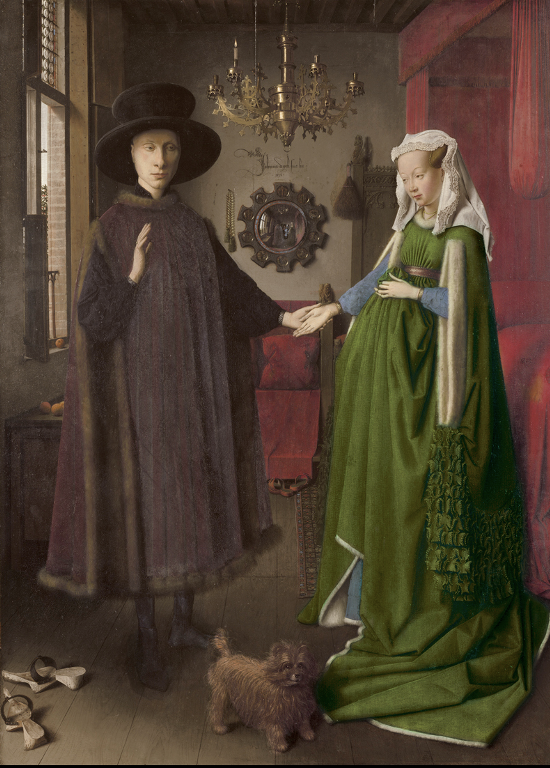
used to think iot was a wedding portrait now more a post morder portrait of arnofini and his wife
Notes on video--à double portrait or memorial portrait , all theories. Was an Italian merchant. Male giving authortyi to female? Importat portant filled with symbolic items(singlc candle of symbol of god). the way they’re joints together. Signature above mirror of artist precense the portrait.
mirror in center a compelling aspect, lil round painting on mirror in enormeuos clarity,
Hair of the dog, dog is a symbol of fidelity.
Curious element become fruit on tree but wearing winter cloth, orange shows wealth. Wealth shown on carpet.
Not pregnant just an expression of the fashion
using oil paint in the way it has never been used, thinned out layer painting creating deep rich colours and subtle light. Love of light. (shows). Northern rainanssance cause of paint texture and detail
-Giovanni was italienne cloth merchant proving fabrics to Burgundian court
-both Patron and Painter are identified with clarity
-Giovanni with personal likeness
-Jan van stamped name above convex mirror and can clearly tell by his painting style
-woman less individualized, lifting skirt over belly to follow Giovanni also seen with hand, may be pregnant unsure
-Identity of couple still debated, only wealth is assured
-surrounded by luxury, man in fur-lined, silk velvet heuque. Woman in costly wool and elaborate cutwork decoration. Painting itself showed value
-full of sacred meaning:crystal prayer beads showing couples piety; mirror symbol of of the all seeing of god and is framed of scenes of christ passion; St-margaret carved at the top of post on chair;dogs symbolize fidelity and funery associations and is an ornamental breed
part oF ghent alter piece
Jan Van Eyck was here id written above mirror almost as a witness, another witness can be seen in mirror
unknown meaning
The northern Renaissance
french for rebirth
interest in the natural world
Altars and Alterpiece
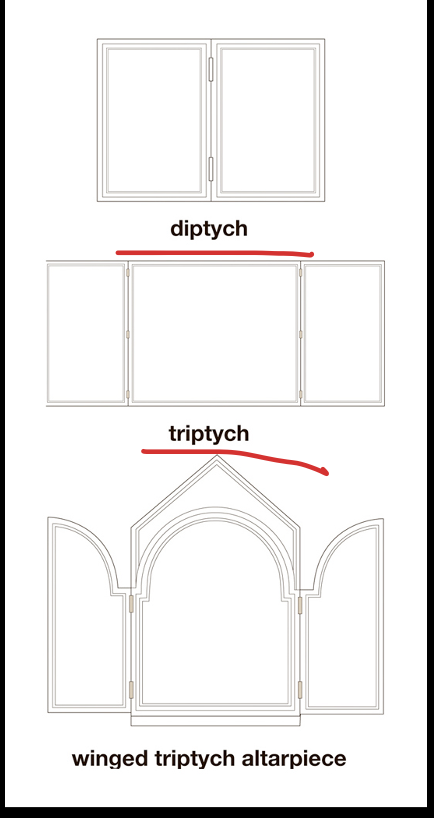
ex chartreuse de champmol
altar symbolizes the table of jesus’s last supper and the tomb of Christ and saints.
table for priest and mass, tomb usulaly had relic
Winged alter piece is DIPTYCH Two panels hinged
Triptych =2 wings fold over a center section, forming diptych when closed
Polytych=more than 3 panels
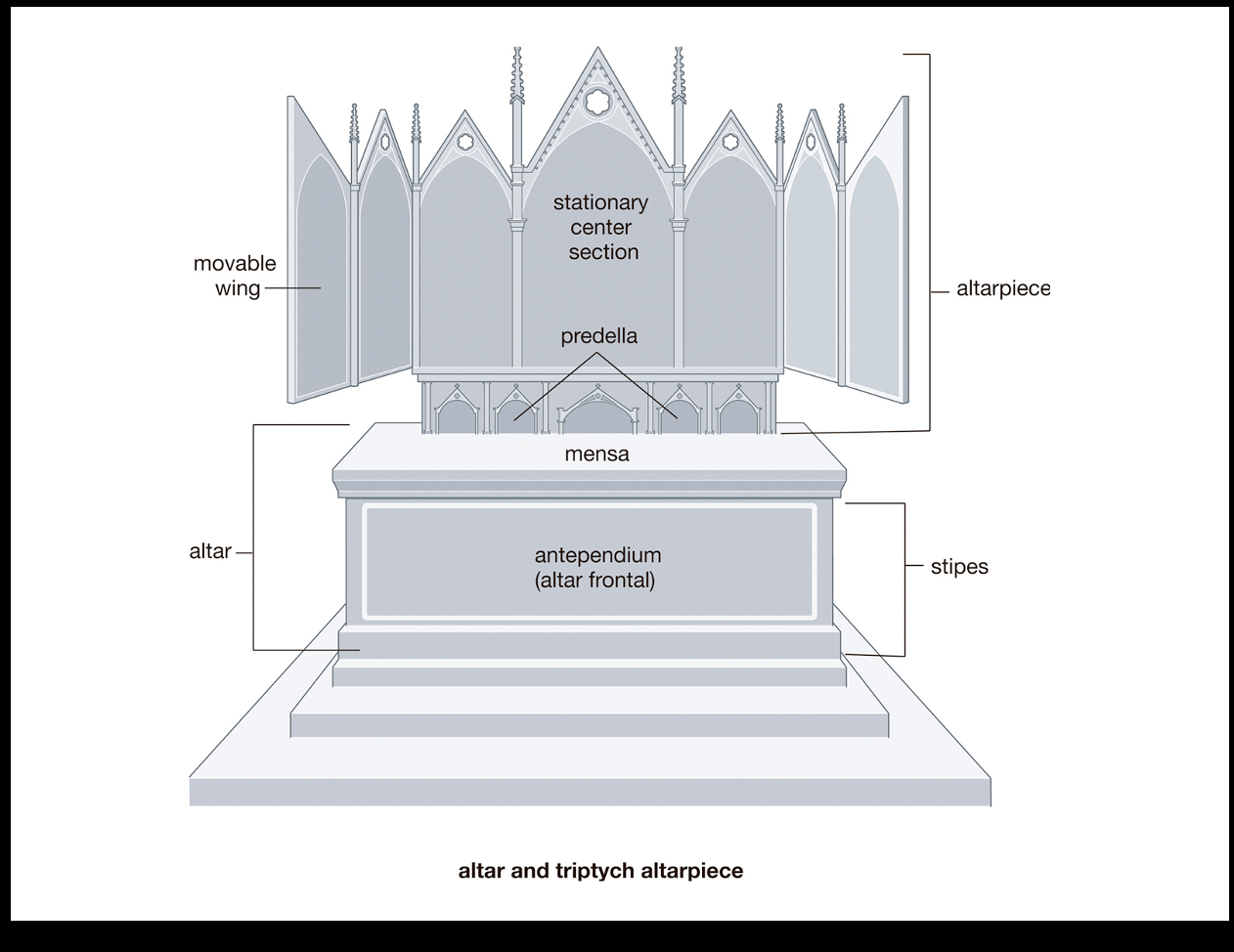
Mary of Burgundy Painter MARY AT HER DEVOTIONS, HOURS OF MARY OF BURGUNDY
Before 1482.
Colors and ink on parchment, size of image


Painted book of hours for Mary of Burgandy,, only child of Charles the bold
book of hours
71/2 by 51/4inch
earthly reality +relgious vision
cOMPLEX PICTORAL SPACE-looking through window and through and actual window
viewer in far reaches of church to gilded alter-piece where 2 ppl talking
Mary headress is detail along with vase and bull’s eye glass
mary appears twice, reading from window and foreground of personal vision inspire by her private meditation
Gothic church but not mass
Shes in private for meditation
Christians at this time were encouraged to to image themselves participating in biblical stories and sacred events to experience the protagonist
in her vision she kneels with attendants + angels in front of gracefully human virgin and child
Reading book of out, must be wealthy because book is costly,
large pice of jewelry
large hat
lots of symbolism,
window into her devotion, maybe a vision in her mind
Play of optical fantasy
angels around her therefore not eart, heavenly realm
angles look like northern renaissance
white washing
Manuscript Illumination
Paul, Herman, and Jean Limbourg FEBRUARY: LIFE IN THE COUNTRY, TRÈS RICHES HEURES
1411-1416. Colors and ink on parchment, 11-3/8" .
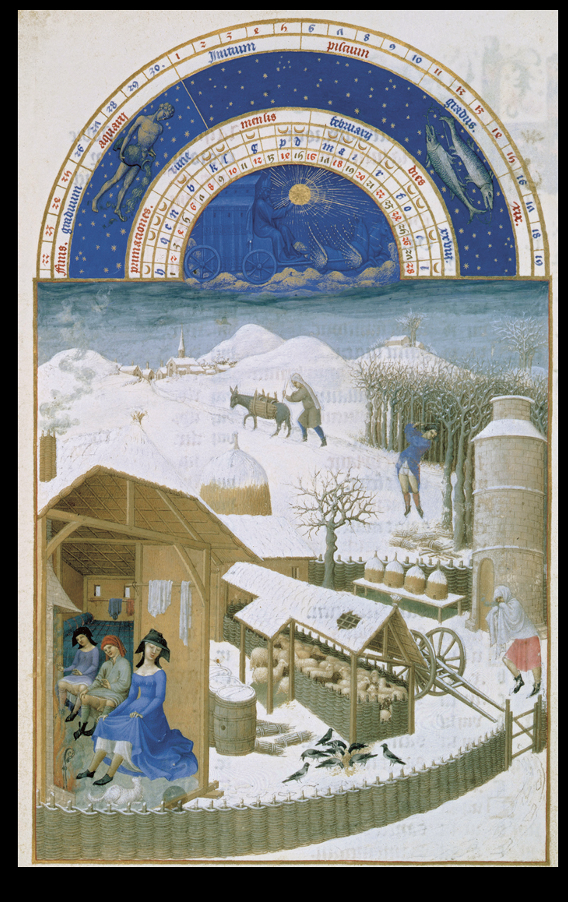
Paul, Herman, and Jean Limbourg JANUARY: LIFE IN THE COUNTRY, TRÈS RICHES HEURES
1411-1416. Colors and ink on parchment, 11-3/8" × 8-1/4" (29 × 21 cm).
Musée Condé, Chantilly, France.

(left)
Limbourg brother owned workshop, and assistants worked under them, everyone had a niche (script, illumination).Focus on picture, skill is present, artistic choices
some of finest netherland painters
ppl did not have last names but last name were from what region they were from
book of hours, with readings + prayers and calander of holy days
full page illustrations for calendar.
for every month illustrations had both peasent labor and aristoratic pleasure on lower field with calendar devices of chariot of sun + zodiac symbols in semicircular area
shower lower class in light +acceptable details
peasants seem to be enjoying leisureness
image desc: farm folk beside fire. usually live in hovels but shows farm is well maintained
church + village in distant
Hierarchy of class
women closest is farm owner, shareing fire with coouple who are less behaved as their father is away,
converys cold weather
gothic conventions=High placement of horizontal line, small trees and buildings compared to ppl, , house showing both exterior and interior. Mutes palette struck with diff colours. Scale relationship is consistent.
Image 2: january showing aristocratic house hold
Duke of berry behind table with lavish items and food, servants +allies
Chamberlin invites coutiers to meet the duke who’s singles out by red cloth of honor with arms and halo in the back.
tapestry battle scenes over wall
Zodiac still a big use of practice and interest
wealthy patron could afford the books
great disparity during this time
gentle showing of peasants to make higher class not feel bad
highly censored of peasent , this would continue until realism
Interior view buttttttt there would be a wall, artist are taking liberty of an inside and outside view at the same time but this isn’t a reality
-lavish object compare to February
Describe the Technique: Oil Painting
•Limitations of tempera paint resulted in the Flemish preference for oil paint.
•It is a viscous medium that has time to smooth out during the drying process.
-flexible and luminous
-in linseed and walnut oil
-tempera is matte
•Additionally, it can be applied in thin layers called glazes that can create the appearance of an interior glow.
•Civic groups, town councils, and wealthy merchants were important patrons in the Netherlands.
•Guilds oversaw nearly every aspect of members' lives.
§Artists who moved from one city to another had to work as assistants until being granted guild membership, regardless of experience
what is Majolica and picture plan
Glazed earthen ware
picture’s front surface
what is silverpoint
common preliminary step used by 15th cent flemish painter in the planning of the paintings
ex:rogier Flémalle, van der Weyden in ste.luke drawing
what is crockets
associated with flamboyant architecture known as" small, knobby, leakf like ornaments that line the steep gables and slender buttresses
describe Technique: Woodcuts and Engravings on Metal

•Woodcuts are made by cutting away areas around drawn lines on a block, leaving the lines in high relie using a gouge
•Engraving one metal uses burins to cut into the metal plate a technique called intaglio.Polish the plates, ink applied going into the crevices then the top layer of ink is wiped and when the paper and plate are help by a press the ink from crevice is transfered.
makes identical images
mulyiple prints are called edition
•Making multiple prints from a single version was a team effort.
ex graphic art, germanic lands, The buxheim or the temptation of st.anthony
printin press emerged en of 14th cent
Printed books
Michael Wolgemut, Wilhelm Pleydenwurff, and workshop THE CITY OF NUREMBERG
Nuremberg Chronicle, published by Anton Koberger in 1493.
Woodcut within a printed book, hand-colored after printing,
each page
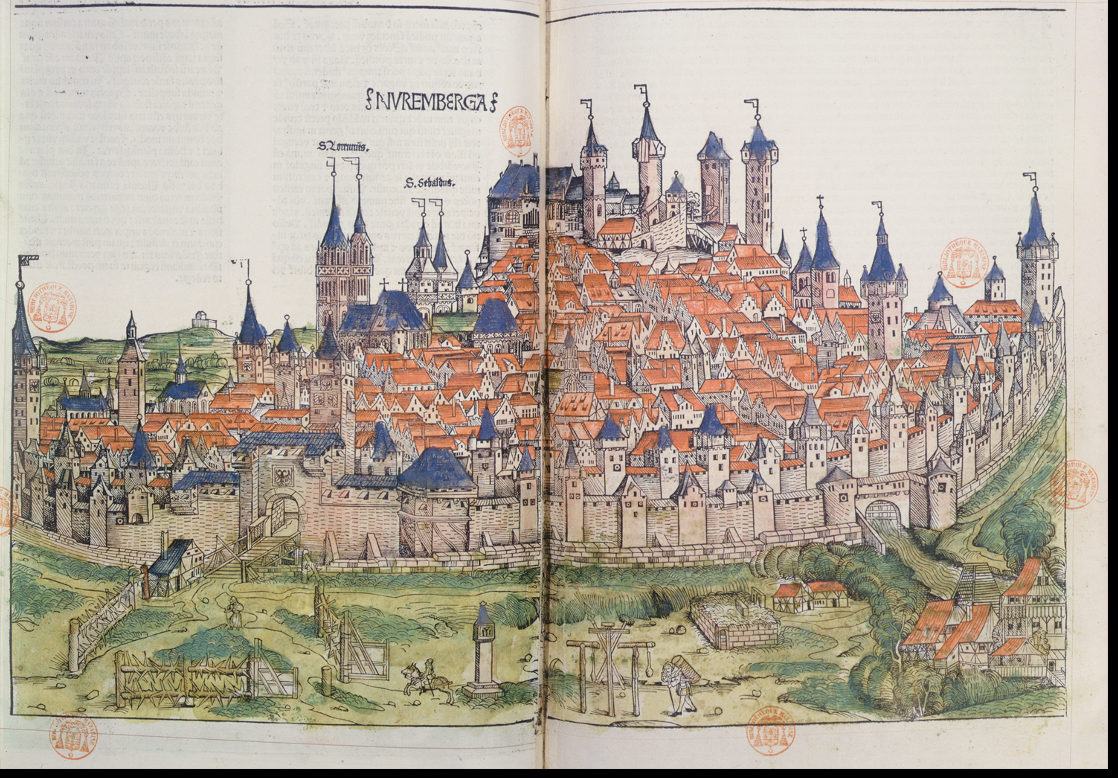
explosion of learning in 15th cent encourages experiments in faster and cheaper ways of producing books
earliest books were block books, each text cut onto wood.
movable type writing achieved by Johann Gutenberg in Mainz germany
more than 40 copies of Gutenburg bible printed out
The Nurember chronicle: culmination of his complicated collaboration with scholars, artist and investors in early capalist enterprise.
text of history of the world was compile by physician _ scholar Hartman Schedel drawing work from collegues
Koburger sough financial support from Sebald Schregel and his brother in alw
and contracted wth other to produce the woodcut illistration and in 1491 to work on the layout
published in 1493 in editio on 2500
1809 illustration were dispered across book of pages or tucked into text
offered in latin or german on parchment or paper, bound or unbound, as is or with colour
only double paged picture, filling entire opening with little texte is a panoramic view of the city of Nuemberg
sight of significant artistic development